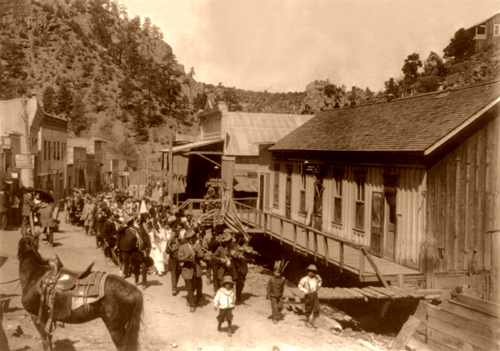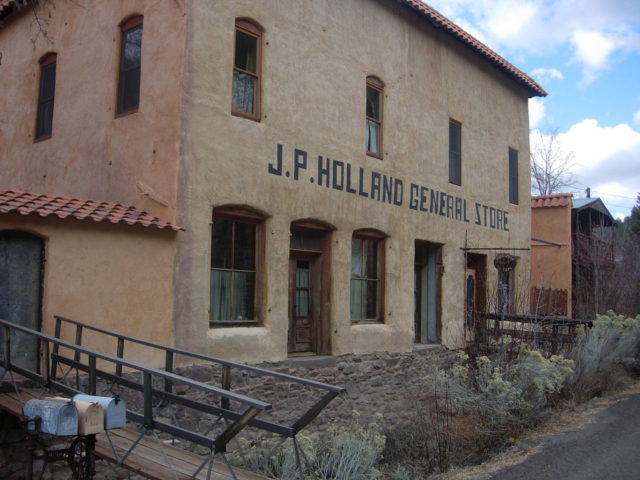No story about the American Wild West is complete without a ghost town. Southwestern New Mexico is thick with towns that flourished with miners prospecting for turquoise, uranium, silver, copper, gold, coal, and oil. It has been estimated that there could be as many as four hundred old mining towns that were abandoned after the mines had nothing left to give. While mining towns stretched from Farmington, just south of the Colorado border, to Las Cruces, just north of Ciudad Juarez and El Paso on the Mexican border, most of the abandoned towns are concentrated in the area south of Albuquerque.
Many of these towns still have a small population, mostly those who work retail establishments servicing the tourist trade. A few are available for the public to visit and explore with only a few buildings off limits because of safety reasons due to their state of disrepair.

Hillsboro, about 32 miles west of Truth or Consequences, was founded in 1877 when gold deposits were discovered on the east side of the Black Range Mountains. It was initially a tent city filled with miners out to get rich quick. As time went by, buildings of wood and adobe gradually replaced the tents. By 1800 saloons, mercantile stores, and a post office became permanently established. Hillsboro still has a small population which is, unfortunately, steadily declining. As one walks around the town, the present intrudes on the past with the mixture of newer buildings surrounded by the footprints and remains of old houses, businesses, and churches.
The town of Lincoln, famous for the Lawrence Murphy and Jimmy Dolan store where Billy the Kid killed two deputies while fleeing arrest, is one of the most popular tourist attractions in New Mexico. Primarily owned by the state, it often attracts up to 45,000 visitors a year. When the town was founded in the 1850s, it was called Las Placitas del Rio Bonito by Spanish settlers but was changed to Lincoln in 1869 when Anglo-Americans reestablished the town and named it after the sixteenth President.
Lake Valley, which is 17 miles southwest of Hillsboro, is a true ghost town with rickety, old buildings and no residents. During the mid-1800s it is said that the Bridal Chamber Mine produced over two and a half million ounces of silver and became an important stop along the railroad. The Panic of 1893 put a stop to the silver mining at Lake Valley, and the town was eventually abandoned. The Bureau of Land Management has restored the old schoolhouse and turned it into a small museum exhibiting old artifacts donated by local residents. The chapel has also been restored and is open to visitors.

When a vein of gold was found in Baxter Mountain, the town of White Oaks near Ruidoso became more of an eastern-style town than the flat-roofed adobe structures that one usually associates with a western town. When lawyers flocked to the town to ensure the legality of claims, they built Victorian-style homes with pitched roofs and long porches. At the time, White Oaks was the second largest city in New Mexico. The town leaders felt that this would be a good place to have train service but the railroad wasn’t interested. Not long after that, the gold vein went dry, and the town was no more. There are still a few buildings including the “No Scum Allowed” Saloon, which is still in business and was named one of the best cowboy bars in the West by American Cowboy Magazine.
Mogollon was one of the richest mining towns, playing host to the likes of Butch Cassidy, Geronimo, professional gamblers and claim jumpers. Just northwest of Silver City, the town had a population of two thousand people by 1901. Mogollon mines produced about $19.5 million in copper, silver, and gold in its heyday and had restaurants, a photography studio, retail stores, two hotels and several brothels. As always, the mineral deposits ran dry, and the town residents went elsewhere to seek their fortunes, leaving behind the buildings that once held the hopes and dreams of wealth and prosperity. Also left behind are the remains of the townspeople buried in the local cemetery off Graveyard Gulch where one can see the names of the individuals that inhabited Mogollon. Today, Mogollon still has a few seasonal residents and a few businesses to support them but is mostly filled with abandoned buildings that once held the residents of a busy, prosperous mining town.
These are only a few of the many ghost towns that can be found in the state of New Mexico, but some areas are still active in harvesting minerals and energy from the earth. Grants, New Mexico is still actively drilling for oil and Farmington still has an active coal mine. In an area rich in resources, one can only wonder when and where the next big discovery will be made.
In addition, check this awesome video about Ghost Towns:
https://www.youtube.com/watch?v=aHJAoR0Jw58
